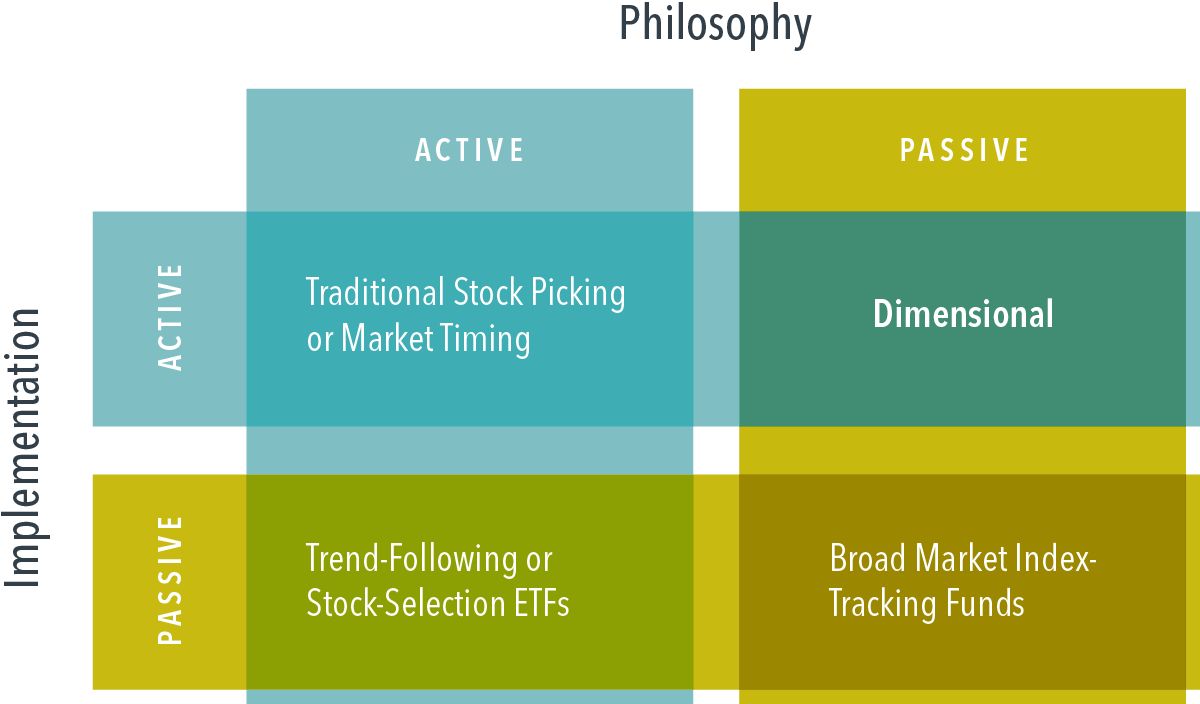
The active versus passive debate may still raise a pulse in some circles.
But Dimensional’s Head of Investment Strategists, Wes Crill, argues those labels don’t mean much anymore.
In our case, we’re passive in philosophy and active in implementation.
Key Takeaways
– Evolution of the investment landscape has rendered binary active/passive labels outdated for comprehensively describing an investment strategy’s approach.
– A more nuanced framework is to assess the active/passive distinction separately for a strategy’s philosophy and its implementation.
– Dimensional’s systematic investment approach combines a passive philosophy with active implementation.
As a member of probably the last generation to grow up with a rotary dial phone in the house, I can still recall when there was clear distinction between phones and computers. Phones were utilitarian devices, while computers were gateways to limitless knowledge and entertainment.1 Nowadays, that distinction has dissolved. For many consumers, phones arguably obviate the need for a personal computer.
Similarly, evolution in finance has etched away the apparent cut-and-dried distinction between active and passive investing. The current landscape suggests the characteristics implied by such traditional, binary labels may not be sufficient to describe many of today’s investment approaches. A more nuanced framework takes the spirit of active and passive definitions—betting against market prices vs. embracing them—and examines how it applies to an investment’s underlying philosophy and implementation.
Diminished Distinction
Index investing emerged amid a growing body of evidence showing that traditional active methods of attempting to select stocks and time markets were ineffective. Studies documenting underperformance by active fund managers supported the sentiment that market prices were largely fair and any attempt to find under- or overpriced securities was akin to flipping a coin. So, the arrival of index funds represented a shift towards embracing market prices—if you can’t beat ’em, join ’em!
Because early indexing didn’t spin its wheels in bottom-up company analysis or top-down economic trend forecasting, it became known as passive investing. However, this stretches the definition of “passive.” A sailboat without its own propulsion must still be actively manipulated to keep wind in its sail. Indexes are not perpetual motion machines free of maintenance, but require periodic management through additions, deletions, and security reweighting. Index construction rules are often designed to accommodate the mutual funds and exchange-traded funds (ETFs) tracking the indexes, reducing index turnover, for example, by limiting the number of rebalancing events and imposing thresholds on security weight changes.
Also blurring the line between active and passive is the fact that some investors may use index funds to pursue an active investment approach. For example, the largest S&P 500 ETF had the highest average daily trade volume of US-listed securities in 2021, at $31 billion USD.2 It is reasonable to assume a portion of that trading activity represented asset allocation changes motivated by market viewpoints, rather than buy-and-hold position accumulation.
A more evolved process for categorizing investments applies the active/passive label separately for a strategy’s structure/implementation and its underlying philosophy. While some investment approaches still appear active or passive through and through under this framework, many investment styles have a foot in both camps.
Stock-picking and market-timing strategies would universally be described as active, and the 2×2 framework in Exhibit 1 shows how this label is earned. These approaches are rooted in an active philosophy that implicitly presumes mispriced securities or market segments can be identified. This philosophy is executed in an active structure that deviates from the market in an attempt to exploit mispricing opportunities.
Broad market index funds, on the other hand, fit a passive definition along both dimensions. The raison d’être of index funds is an acceptance of the market’s pricing power, a concession that trying to outguess markets is unlikely to succeed in the long term. The structure of the broad market index funds is true to that belief, generally holding the entirety of the prescribed asset class or market segment with no deviations motivated by expected-return goals.
EXHIBIT 1
What’s In a Name?

Expansion of the ETF landscape has spawned a segment of index ETFs that do not track broad market indices, instead offering more targeted exposure for investors who are looking to time markets or concentrate on particular stocks. For example, you can find a social sentiment ETF that holds the top 75 large cap stocks based on investor exuberance measured through channels such as social media and news outlets. Another example is a millennial-themed consumer ETF that seeks to ride the coattails of companies benefiting from millennials’ consumption preferences. I hope its prospectus isn’t written in cursive!
These are but two examples of index funds that sit apart from traditional passive approaches. They track indices, so are passive in structure. But the philosophical underpinning of these niche ETFs would seem inconsistent with an acceptance of market prices. An investor who believes stock prices reflect available information about companies likely would not see the appeal of an allocation to trendy stocks based on a belief in their growth potential. Our framework assigns an active/passive designation to these index ETFs.
The final quadrant expresses Dimensional’s approach, which starts with a firm belief in the power of markets. In that sense, our philosophy is aligned with the industry’s original shift to passive. We use the information in prices throughout our investment process with an aim to increase expected returns daily, seeking to add value above markets and benchmarks. The implementation is therefore active—we are not beholden to the construction rules of an index. So, we land on passive/active: an approach that seeks to outperform markets without trying to outguess them.
REFERENCES:
FOOTNOTES
-
1I am not quite old enough to remember when computers, too, were utilitarian devices.
-
2Source: Bloomberg
DISCLOSURES
The information in this document is provided in good faith without any warranty and is intended for the recipient’s background information only. It does not constitute investment advice, recommendation, or an offer of any services or products for sale and is not intended to provide a sufficient basis on which to make an investment decision. It is the responsibility of any persons wishing to make a purchase to inform themselves of and observe all applicable laws and regulations. Unauthorized copying, reproducing, duplicating, or transmitting of this document are strictly prohibited. Dimensional accepts no responsibility for loss arising from the use of the information contained herein.
“Dimensional” refers to the Dimensional separate but affiliated entities generally, rather than to one particular entity. These entities are Dimensional Fund Advisors LP, Dimensional Fund Advisors Ltd., Dimensional Ireland Limited, DFA Australia Limited, Dimensional Fund Advisors Canada ULC, Dimensional Fund Advisors Pte. Ltd., Dimensional Japan Ltd., and Dimensional Hong Kong Limited. Dimensional Hong Kong Limited is licensed by the Securities and Futures Commission to conduct Type 1 (dealing in securities) regulated activities only and does not provide asset management services.
AUSTRALIA and NEW ZEALAND: This material is issued by DFA Australia Limited (AFS License No. 238093, ABN 46 065 937 671). This material is provided for information only. No account has been taken of the objectives, financial situation or needs of any particular person. Accordingly, to the extent this material constitutes general financial product advice, investors should, before acting on the advice, consider the appropriateness of the advice, having regard to the investor’s objectives, financial situation and needs. Investors should also consider the Product Disclosure Statement (PDS) and the target market determination (TMD) that has been made for each financial product either issued or distributed by DFA Australia Limited prior to acquiring or continuing to hold any investment. Go to au.dimensional.com/funds to access a copy of the PDS or the relevant TMD. Any opinions expressed in this material reflect our judgement at the date of publication and are subject to change.
RISKS
Investments involve risks. The investment return and principal value of an investment may fluctuate so that an investor’s shares, when redeemed, may be worth more or less than their original value. Past performance is not a guarantee of future results. There is no guarantee strategies will be successful.





